Gigabyte GA-EP45-UD3P - P45 at its Finest
by Gary Key on February 3, 2009 12:15 AM EST- Posted in
- Motherboards
Software
GIGABYTE provides several software applications with the GA-EP45-UD3P, EasyTune6 and D.E.S Advanced being the two main ones.
EasyTune6
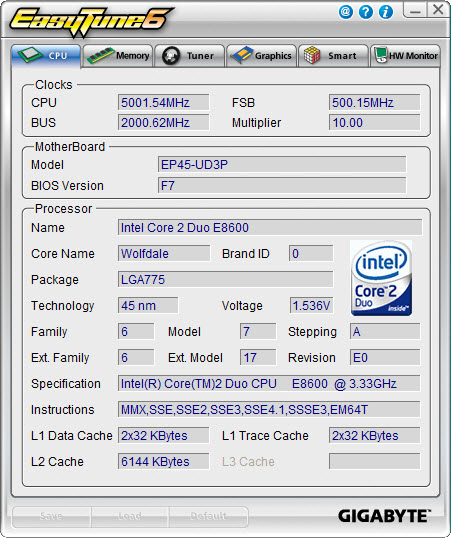
GIGABYTE's EasyTune6 application provides monitoring, system information, and overclocking capabilities. This is one of the best applications provided by the various motherboard suppliers for tuning a system within Windows. We would still like to see additional voltage readings and the ability to save the settings to the BIOS - or at least a BIOS profile. Other than that, this application is useful for extracting a decent amount of performance improvement out of the system after booting Windows. One benefit of such an approach is that you can reduce performance - along with power requirements and the stress on a system - without rebooting.
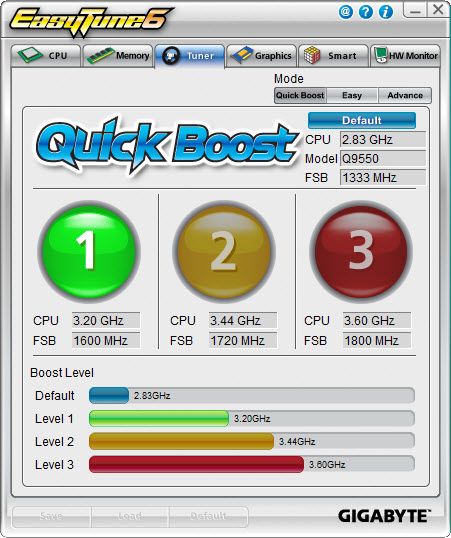
Quick Boost mode is a new feature that GIGABYTE introduced along with Ultra Durable 3 on their motherboards. It is a simple way for novice users to quickly overclock their systems without entering the BIOS. Once you click on one of the three boost levels, the utility will automatically optimize system settings according to your specific hardware combination. The program is based on algorithms of hardware that has been pre-tested by GIGABYTE engineers.
We tried about twenty-five different hardware combinations and 24 out of the 25 worked correctly. While not perfect, it was commendable that a majority of hardware combinations worked as advertised. GIGABYTE is constantly updating the application for product compatibility. Our testing indicates that users with recently purchased hardware will not have any trouble with Quick Boost.
The combination that did not work properly happened to be with our standard test setup today. On the first setting, we wanted to take our 2.83GHz Q9550 to 3.2GHz. Sounds simple right? We hit the first boost level, rebooted, and Vista loaded without a problem. We checked our settings and sure enough, the system was operating at 3.2GHz with an 8x CPU multiplier, 400FSB, memory set to DDR2-1066 at 5-5-5-15. Voltages were all set to stock except VDimm was increased to 1.9V per the SPD. We started our first benchmarks and the system crashed. It crashed repeatedly as a matter of fact. The problem is that Quick Boost set the FSB strap (MCH Latch) from 333 to 200 in order to run the memory at 1066. However, it did not raise the MCH voltages to compensate for the additional load on the memory controller.
We sent in a trouble ticket to GIGABYTE Technical Support. We received a standard reply that overclocking is not guaranteed even though we more or less laid out the problem for them. This was the one time we had a problem with technical support. Our other technical support tests ranging from flashing the BIOS to enabling SpeedStep were answered correctly. We ended up escalating this problem to the Technical Marketing Group and within 24 hours we had a new BIOS delivered to our in-box that fixed the problem. Our FSB strap stayed at 333 and the memory was set to DDR2-800 on the 1:1 ratio with 4-4-4-12 timings per the SPD.
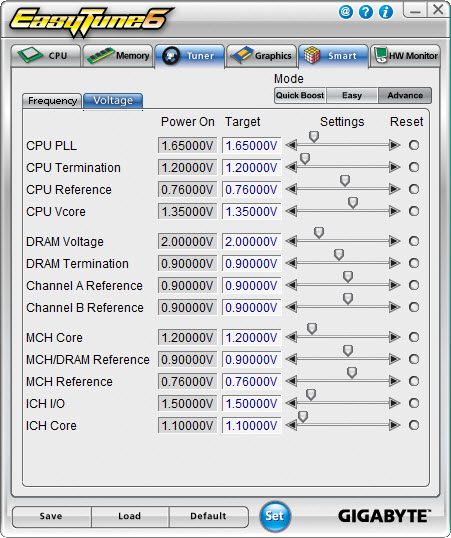
For those who appreciate and want a manual approach to overclocking, the Tuner tab has two different options. Easy mode allows control over the front side bus, but it is Advance mode that opens a slew of on-the-fly tweaking options that actually work. You can adjust the front side bus, processor multiplier, memory multiplier, PCI-E frequency, and numerous voltage options.
We have to say that using EasyTune6 was a pleasure. We repeatedly loaded this application first after getting the OS installation up and running. ET6 is definitely a huge help in tweaking those final settings to find a motherboard's overclocking limits.
DES
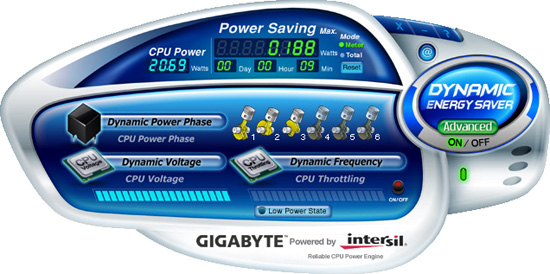
One of the most highly touted features from GIGABYTE is their Dynamic Energy Saver (DES) advanced power management solution. GIGABYTE provides a Windows-based software application to control DES. After installing the software (we highly suggest downloading the latest version) and a quick reboot, the application is ready for use. The control panel is powered down by default and it is up to the user to turn it on with a simple click of the DES button.
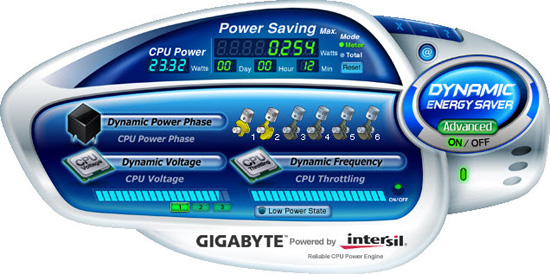
The DES software is simple to use and easy to understand. GIGABYTE provides a power savings meter in the top portion providing us with power savings information that can be reset at startup; otherwise it will track the power savings since the installation of the product. Real-time CPU power usage is available along with a graphic representation of the phases in use. You can also enable CPU throttling to save additional power during operation. GIGABYTE also includes an onboard LED system that indicates the number of phases in use. These LEDs can be turned on and off from the control panel. The user can also utilize DES while the system is overclocked, something most power saving programs do not allow.
















73 Comments
View All Comments
Norm VH - Monday, August 17, 2009 - link
I am rebuilding in an old computer case using the Gigabyte EP45-Ud3P motherboard. Have new e7500 cpu. New evga 9500 Gt video card. new Corsair ddr2 ram and a new antec earthwatts psu. Before I add all the rest of the items I am checking fan features. Board lights come on. Case fans work. video card fan works. But the Zalman 9700 fan just jumps a little and stops. The Intel fan that came with the CPU does the same thing. Tried cpu fans in both cpu_fan 4 pin and the sys_fan2. Is this normal? Is the fan waiting for the CPU to heat up? I returned a motherboard to Fry's for the same behavior. They said fans should start. I tested the fans on an old asus motherboard and they are working.Isme - Thursday, December 3, 2009 - link
Yes On my EP45-UD3L there is a warm up time before the CPU fan needs to turn on. Its not long for most heat sinks. Maybe 5-10 seconds. You see the CPU fan twitch then sit idle for a time related to how big the heat sink itself is.For modern CPUs you should not need to worry about CPU overheat while messing around with the CPU fan unless you already have cranked voltages for extreme overclocking. The CPU should shut itself off within 10C and 30 seconds of reaching maximum normal operating temperature. I would not do any overclocking until you get fans and other basics working.
lancerocke - Friday, July 24, 2009 - link
so there is no fix for this crackling audio?i kinda want to return this board now.
Voldenuit - Tuesday, August 18, 2009 - link
Sadly, I just got an EP45-UD3P Rev1.1, and the onboard audio still crackles. :(Running Win7 Ultimate RC.
syseng - Friday, June 12, 2009 - link
My second Gagabyte board of this model has died. The first one was DOA and this second one died more gradually. The problem is that it woudl sometimes refuse to turn on or off with the power button. Pressing the button mutliple times or holding it in sometimes worked. Finally, it would not power up at all. I have grounded the pin 16 of the system power connector to start and run the system until I can get a replacement. I have read many comments from varous forums of people having power control problems with this board. Mine was never over-clocked and no power management control was on.Gigabyte will not ship a replacement until they receive the dead board and test it. Estimated round trip time to get the board back is about 3 weeks. Probably the last Gigabyte for me. When I built this system in March, I ordered a Gigabyte 4850 graphics card (all from Newegg) and it was DOA too.
I am just wondering if I am incredibilty unlucky with Gigabyte or if they really have a quality problem. They certainly have a customer service problem if they think it is acceptable to have a system down for 3 weeks.
keithh - Wednesday, May 13, 2009 - link
I decided to give Gigabyte a shot for my latest system build and purchased the EP45-UD3L for the kid's linux desktop. I was using a PATA DVD drive to install to an older IDE HD. After the installation started, the system abrupty died. After resetting, the bios was unable to see the drives. Cutting a long story short, I concluded that the motherboard was bad and exchanged it.The second board had exactly the same problem.
After switching to an ASUS motherboard, I had no problems.
I eliminated the following possibilities during my investigation:
- master/slave settings
- IDE cable
- DVD drive
- IDE drive (tried a SATA drive from another machine)
- RAM test
- BIOS revision (F2 -> F4 didn't make a difference)
- installing Windows XP from a disk that is known to be good
- installing two different Linux distributions including Fedora 10.
It uses the JMicron 368 PATA chipset which has a dodgy reputation so conceivably using a SATA DVD drive and a SATA HD would have worked.
The power supply was a brand new Corsair.
That doesn't leave a lot of room for interpretation - I was 0/2 on the Gigabyte MB. I wasn't impressed.
syskin - Saturday, February 21, 2009 - link
Hi, I have one question which is very important to me.If I:
- overclock FSB and
- set a higher Vcore voltage and
- activate EIST/speedstep,
...will this motherboard still lower Vcore at idle (as per speedstep) or will it keep it at bios setting all the time?
Thank you in advance.
foofoo - Tuesday, February 17, 2009 - link
I have 2 x 2GB RAM installed and winXP pro 32 bit only sees 2.5GB. The BIOS (f7) sees all 4GB. Changed RAM and slots with the same results. I put in a trouble ticket to Gigabyte support and got the following response (or non-response)"You will need to use 64 bit OS in order to see the full 4gb capacity or higher
Windows will automatically reserve an certain amount of memory being used and there are no way to adjust it"
All other gigabyte boards that I have used (965 and P35 chipsets) show 3.5GB with 4 installed under XPpro. This is actually a game stopper for me since losing that much RAM affects the usefulness of my PC.
Fair warning for all wanting to use a 32 bit OS with this board.
Isme - Thursday, December 3, 2009 - link
Make sure you are looking at BIOS RAM reports especially the POST. Or I'd use the Task Manager Physical Memory report or the built-in Windows Accessories-System Tool-System Information-System Summary tab-Total Physical Memory line before I panic about hardware issues. Note that on one of my computers I have only 1.19GB available out of 2029MB. Application reports of RAM are pretty much useless except for that application at that point in time with whatever else happens to be running. Know how 3rd party utility tools define available RAM.Well the amount of RAM visible varies. Depending on OS and reporting tool 1GB may be reserved for the OS. That is the standard 32-bit Windows OS only has 3GB RAM for user purposes. With older very basic peripheral devices and XP that often included memory mapped IO space. But with newer larger OSes and huge numbers of motherboard ports and video cards sporting 1GB+, dedicated SATA port buffer frames, dedicated buffers for fancy network ports...
Remaining RAM space, especially user space, may be more dependent on how much of the 4GB space is mapped for peripherals in your particular setup. I would not be surprised if some video cards are mapping 512MB or more to main memory as a window now that 1GB+ video cards are common. I suppose a less considerate video BIOS might even automatically reserve space for an X-fire setup even if you are not using one.
pudlglum - Sunday, February 15, 2009 - link
Thanks for all the excellent knowledge on the AnandTech Forum. I believe this is my first post on any forum, and I've been into PCs since purchasing my brand new Compaq Portable 286, with 256K ram and a single 1.2 Mb floppy.I've had a GA-EP45-UD3R running for about a week. All components are conventional, all good quality, nothing is "bleeding edge", and I'm not overclocking. I have an ATI Radeon HD 4350 PCI-e graphics card, connected to a Hitachi CM751 CRT monitor. Two WD SATA hard drives are connected to the Intel (yellow) connections, configured in the BIOS to IDE mode. My reliable Plextor PX-760A CD/DVD burner is connected as "master" to the single IDE connection.
Everything was smooth except for two things: occasionally the screen resolution was corrupted when resuming from standby, and I was getting disk write failures from both an old (4X) CD burner and my recent Plextor PX-760A CD/DVD burner.
I downloaded whatever recent drivers I could find; the video problem hasn't recurred, but ImgBurn or CDBurnerXP both froze while attempting to write an iso image (Windows 7 Beta) to a DVD. ImgBurn locked both itself and Explorer, and required a forced reboot. CDBurnerXP Pro provided the following error message:
Writing Error: (3) Error occurred writing data to disc.
The SCSI/ATAPI bus was reset and caused a write failure (1026).
Error Sense Data: SENSE KEY: 6 ASC: 29 ASCQ: 0
Apparently both IDE and the purple SATA2 connectors are controlled by the "Gigabyte SATA2" chip, enabled in my BIOS in IDE mode. It is listed in the Device Manager "SCSI and RAID controllers" section as "GIGABYTE GBB36X Controller", with driver provider "JMicron Technology Corp". I was distracted by several suggestions that the JMicron driver was buggy, but that was just a wild-goose-chase.
I then pursued some marginal comments about DPC latency. The comments were typically in the context of audio crackling issues, which I had not (yet) noticed. However, several posts also referred to the Gigabyte Energy Saver service. I had not knowingly installed that package from the Gigabyte motherboard CD, but I found the GSvr.exe service running, with description "GEST service for power management". It also appeared in my Start menu, under GIGABYTE > EnergySaver.
I downloaded DPC Latency Checker V1.1.0 and discovered that my latency was averaging around 500µs, with all "foreground" applications closed, and with Windows Desktop Search and Avast Antivirus disabled. Running ImgBurn in this condition resulted in a another DVD coaster.
After hard-rebooting, I disabled the GSvr.exe service, and confirmed that the DPC latency dropped to around 5µs. This time, ImgBurn successfully wrote the iso file to the DVD (yay!).
I have now uninstalled GSvr.exe (GIGABYTE > EnergySaver > Uninstall), and re-enabled Windows Desktop Search and Avast. In the last half hour or so, my DPC Latency has continued to average about 5µs, with an absolute maximum of 177µs. I suspect removing the Gigabyte EnergySaver service will solve both my disk burning and standby/wakeup problems.